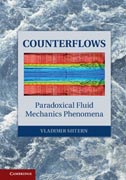
This book discusses the physical mechanisms that drive counterflows, examining how they emerge, develop, become double and multiple counterflows and comprise both global and local circulations. Counterflows play an important role in nature and technology. A natural example is the Gulf Stream and the opposite flow in the ocean depths. Technological applications include hydrocyclones, vortex tubes and vortex combustors. These elongated counterflows are wildly turbulent but survive intense mixing, a seeming paradox. Local counterflows, whose spatial extent is small compared with that of surrounding flows, occur behind bluff bodies and in swirling streams. The latter are often referred to as vortex breakdown bubbles, which occur in tornadoes and above delta wings. Most scale counterflows are cosmic bipolar jets. Most miniature counterflows occur in capillary menisci of electrosprays and fuel atomisers. INDICE: 1. Introduction; 2. Accumulation counterflows; 3. Bifurcation of swirl in conical counterflows; 4. Bifurcation of counter-swirl; 5. Conical counterflows driven by swirl; 6. Jetlike swirling counterflows; 7. Swirling counterflows in cylindrical devices; 8. Separation counterflows; 9. Temperature distribution in swirling counterflows; 10. Onset of buoyancy similarity counterflows; 11. Thermal convection counterflows; 12. Control of vortex breakdown; 13. Magnetic counterflows; 14. Stability of conical flows.
- ISBN: 978-1-107-02759-6
- Editorial: Cambridge University Press
- Encuadernacion: Cartoné
- Páginas: 483
- Fecha Publicación: 15/10/2012
- Nº Volúmenes: 1
- Idioma: Inglés
